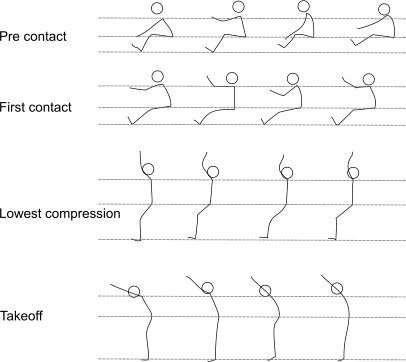Double Mini Trampoline
An Analysis of Mounting Technique
The following article looks at the 2015 Men's Double Mini Trampoline (DMT) team final at the World Trampoline Championships. This year is widely regarded as one of the most exciting competitions in recent history, with lots of highly talented athletes peaking for one event.
Introduction
The DMT mounting technique is one of the most important parts of the DMT routine. It is in this moment where the height of the first skill is determined. Logically, more height equates to more time in the air, giving athletes a greater opportunity for favourable scores and bigger difficulties. This analysis is going to assume that more height is better and analyse all the routines performed in the men's team final.
It is well known that height isn't everything. Angular momentum of somersaults plays a very large role in the aesthetic component of DMT as well as degree of difficulty: greater angular momentum allows for more somersaults to fit in one jump, earlier kickouts and greater position bonuses (tuck → pike → straight)
Methods
Video analysis software, Kinovea, was used to analyse video taken at 240 fps. Time of flight (ToF) was calculated from the video and used as an objective measure of height. Technique was analysed qualitatively.
One identified weakness with the methods is we used qualitative assessment when discussing speed, length and other measurements. This was assessed based on comparison, but not measurement, meaning that there are no quantitative measurements to support the discussion. Qualitative analysis is still a reliable method for assessment but fails to provide exact numbers to compare to and provide benchmarks.
Results and Discussion
Average (+/-SD) mount ToF was 1.38 (+/-0.06) seconds and all data occurred within two standard deviations of the mean. Four athletes had a ToF equal to or above 1.44 sec and two athletes had a ToF equal to or below 1.32 sec.
There are many factors that may influence the height of a mount skill, including run up speed; hurdle length; position on the mount bed; body shaping and technique; and other factors
Run Up Speed
Basic mathematical and physical understanding states that with all other factors the same, a faster run up should result in a greater height and longer (horizontal displacement) mount skill. A greater approach speed gives the athlete greater kinetic energy. The DMT is shaped to help athletes convert the direction of the kinetic energy, giving them a greater height in their first skill. At faster speeds, technique is normally adjusted so that horizontal displacement (length) is accounted for.
Generally, the data confirmed the common understanding. Athletes with a higher ToF also ran faster. In the future, a study with an athletic intervention to improve running speed could be conducted to confirm this finding.
Hurdle Length
Hurdle length did not correlate very strongly with ToF of the mount skill. Athletes with both low and high ToF measurements had varying hurdle lengths. Some athletes had a long hurdle and some athletes had a short hurdle, but it didn't necessarily relate to the height of their mounting skill.
Although hurdle length did not correlate strongly with mount height, this doesn't mean it should be disregarded. Each athlete may also have an individually optimal hurdle length. Further research and interventions would need to be done to establish the optimal hurdle length for individual athletes, and whether an intervention could affect mount height.
Mount bed placement
Nearly all athletes land with their heels in the centre of the mount bed. This may indicate an ideal placement for all athletes, suggesting that athletes should train themselves to target the centre of the mount bed with their heels.
However, this finding may also indicate nothing. As there is no data to compare to for athletes landing high or low on the mount bed, so we cannot confirm whether this affects the height of mount skills.
Technique and body positioning
Athletes who jumped higher in their mounting skill were more vertically compacted just before their contact with the DMT. In other words, the vertical distance between their feet and hips is smaller.
For visual comparison, 4 example athletes are identified and arranged in order of the lowest (on the left) to highest (on the right) ToF.

It is clear from these images that the technique in lower and higher jumping athletes is very similar. All athletes hold their arms low, and their feet high, relative to their hips. Athletes with higher mount ToF have a smaller vertical body length pre-contact.
From this, pre-contact, point, the athletes extend at the hips and flex at the shoulders generating a force against the DMT. Athletes with higher mount skills were able get their arms vertically above their head by the point of lowest compression. At lowest compression, elbows remained slightly flexed allowing for a "throwing" movement into the takeoff.
Throughout the whole contact phase, athletes extend at the hips, maintaining a slight knee bend through the lowest compression. Athletes don't fully extend at the knees until the takeoff phase of the contact. Maintaining slight knee and elbow flexion until after lowest compression allows these athletes to apply force for a longer period of time.
Athletes who did not achieve as high mount skills often:
- Had less hip flexion at pre-contact
- Had less hip extension during the compression of the mount bed
- Extended at the knee early
- AND/OR were unable to maintain hip extension during knee extension
These factors result in either decreased vertical distance or decreased time of force application. Both of which affect impulse, a biomechanical term for change in momentum.
Other factors
Factors such as height and weight can be difficult to measure with video analysis. Short and tall athletes are both able to achieve high flight times. Taller athletes appear to be better at twisting and straight mounts, while shorter athletes appear to be better at triple somersaults. A tall and short athlete who achieve similar heights use a very similar mounting technique.
Weight is likely to also play a role. Acceleration is equal to force multiplied by mass. To accelerate faster vertically, and therefore jump higher, athletes will need to apply a greater force or weigh less. It is more ideal to have a greater power to weight ratio.
Conclusions and recommendations
Technique
The run up should be as fast as possible with the hurdle jump being from a comfortable distance from the DMT. During the hurdle jump, prior to hitting the mount bed, the athlete should raise their feet as high as possible and hold their arms low. As the athlete contacts the DMT, they should explosively extend at the hips and flex at the shoulders. They then continue to push against the DMT by extending the knees and elbows into the takeoff of the skill. At this point, there will be some degree of hip, shoulder or torso flexion to generate somersaulting rotation.
The highest mount skill in this analysis had the following movement profile during contact with the mount bed, this may not be the ideal, but it was the best from the sample.

The first frame (from the left) is pre contact, the second frame is the initial contact with the mount bed, the fourth frame is the point of lowest compression and the final frame is the last contact or takeoff from the mount bed
To achieve these positions, the athlete needs to have strong hip extensors. The first part of the movement is like the deadlift movement but with simultaneous shoulder flexion. The athlete also needs to have strong knee extensors to prevent collapsing in the early stages of the contact with the mount bed. The athlete needs to have good muscular strength and power, as this is probably the most influencing factor to mount height.
